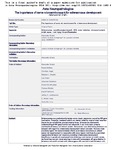The importance of nerve microenvironment for schwannoma development
| dc.contributor.author | Schulz, A | |
| dc.contributor.author | Büttner, R | |
| dc.contributor.author | Hagel, C | |
| dc.contributor.author | Baader, SL | |
| dc.contributor.author | Kluwe, L | |
| dc.contributor.author | Salamon, J | |
| dc.contributor.author | Mautner, VF | |
| dc.contributor.author | Mindos, T | |
| dc.contributor.author | Parkinson, DB | |
| dc.contributor.author | Gehlhausen, JR | |
| dc.contributor.author | Clapp, DW | |
| dc.contributor.author | Morrison, H | |
| dc.date.accessioned | 2016-06-10T08:33:47Z | |
| dc.date.accessioned | 2016-08-30T13:59:50Z | |
| dc.date.available | 2016-06-10T08:33:47Z | |
| dc.date.issued | 2016-05-28 | |
| dc.identifier.issn | 0001-6322 | |
| dc.identifier.issn | 1432-0533 | |
| dc.identifier.uri | http://hdl.handle.net/10026.1/5394 | |
| dc.description.abstract |
Schwannomas are predominantly benign nerve sheath neoplasms caused by Nf2 gene inactivation. Presently, treatment options are mainly limited to surgical tumor resection due to the lack of effective pharmacological drugs. Although the mechanistic understanding of Nf2 gene function has advanced, it has so far been primarily restricted to Schwann cell-intrinsic events. Extracellular cues determining Schwann cell behavior with regard to schwannoma development remain unknown. Here we show pro-tumourigenic microenvironmental effects on Schwann cells where an altered axonal microenvironment in cooperation with injury signals contribute to a persistent regenerative Schwann cell response promoting schwannoma development. Specifically in genetically engineered mice following crush injuries on sciatic nerves, we found macroscopic nerve swellings in mice with homozygous nf2 gene deletion in Schwann cells and in animals with heterozygous nf2 knockout in both Schwann cells and axons. However, patient-mimicking schwannomas could only be provoked in animals with combined heterozygous nf2 knockout in Schwann cells and axons. We identified a severe re-myelination defect and sustained macrophage presence in the tumor tissue as major abnormalities. Strikingly, treatment of tumor-developing mice after nerve crush injury with medium-dose aspirin significantly decreased schwannoma progression in this disease model. Our results suggest a multifactorial concept for schwannoma formation-emphasizing axonal factors and mechanical nerve irritation as predilection site for schwannoma development. Furthermore, we provide evidence supporting the potential efficacy of anti-inflammatory drugs in the treatment of schwannomas. | |
| dc.format.extent | 289-307 | |
| dc.format.medium | Print-Electronic | |
| dc.language | en | |
| dc.language.iso | en | |
| dc.publisher | Springer Science and Business Media LLC | |
| dc.relation.replaces | http://hdl.handle.net/10026.1/4875 | |
| dc.relation.replaces | 10026.1/4875 | |
| dc.subject | Schwannoma | |
| dc.subject | Neurofibromatosis type 2 | |
| dc.subject | NF2 | |
| dc.subject | Tumor induction | |
| dc.subject | Microenvironment | |
| dc.subject | Sciatic nerve | |
| dc.subject | Crush injury | |
| dc.subject | tissue inflammation | |
| dc.title | The importance of nerve microenvironment for schwannoma development | |
| dc.type | journal-article | |
| dc.type | Article | |
| plymouth.author-url | https://www.ncbi.nlm.nih.gov/pubmed/27236462 | |
| plymouth.issue | 2 | |
| plymouth.volume | 132 | |
| plymouth.publication-status | Published | |
| plymouth.journal | Acta neuropathologica | |
| dc.identifier.doi | 10.1007/s00401-016-1583-8 | |
| plymouth.organisational-group | /Plymouth | |
| plymouth.organisational-group | /Plymouth/Faculty of Health | |
| plymouth.organisational-group | /Plymouth/Faculty of Health/Peninsula Medical School | |
| plymouth.organisational-group | /Plymouth/REF 2021 Researchers by UoA | |
| plymouth.organisational-group | /Plymouth/REF 2021 Researchers by UoA/UoA01 Clinical Medicine | |
| plymouth.organisational-group | /Plymouth/Research Groups | |
| plymouth.organisational-group | /Plymouth/Research Groups/Institute of Translational and Stratified Medicine (ITSMED) | |
| plymouth.organisational-group | /Plymouth/Research Groups/Institute of Translational and Stratified Medicine (ITSMED)/CBR | |
| plymouth.organisational-group | /Plymouth/Users by role | |
| plymouth.organisational-group | /Plymouth/Users by role/Academics | |
| plymouth.organisational-group | /Plymouth/Users by role/Researchers in ResearchFish submission | |
| dc.publisher.place | Germany | |
| dcterms.dateAccepted | 2016-05-21 | |
| dc.rights.embargodate | 2017-5-28 | |
| dc.identifier.eissn | 1432-0533 | |
| dc.rights.embargoperiod | Not known | |
| rioxxterms.versionofrecord | 10.1007/s00401-016-1583-8 | |
| rioxxterms.licenseref.uri | http://www.rioxx.net/licenses/all-rights-reserved | |
| rioxxterms.licenseref.startdate | 2016-05-28 | |
| rioxxterms.type | Journal Article/Review | |
| plymouth.funder | Interaction between Sox-10 and the tumour suppressor Merlin in tumours of the nervous system.::MRC | |
| plymouth.oa-location | https://link.springer.com/article/10.1007/s00401-016-1583-8 |


